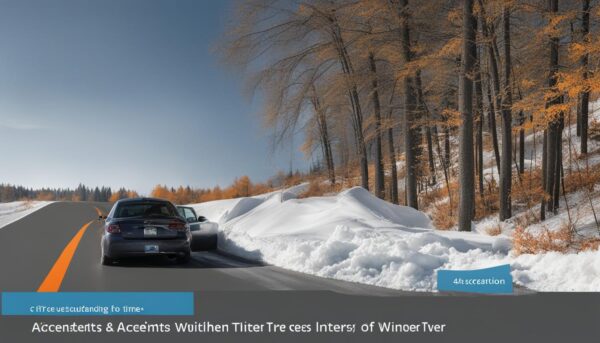Last Updated on 3 months
The Impact of Winter Tire on Reducing Road Mishaps
With winter weather bringing challenging driving conditions, there’s a growing interest in using winter tires—also known as snow tires—to enhance driving safety and reduce accidents. A study conducted in Canada revealed that the number of injuries from winter road accidents decreased by 5% with the universal usage of winter tires. In comparison, fatalities and serious injuries saw a decline of 3%. Similar benefits can be expected in northern U.S. states with comparable winter weather, so it becomes essential to raise awareness about the advantages of cold weather tires in the United States, where winter tire usage is only 16% in northern states.
Key Takeaways
- Winter tires, also known as snow tires, can significantly improve driving safety in cold weather conditions.
- A Canadian study shows a 5% decrease in winter road accident injuries with the universal usage of winter tires.
- Northern U.S. states can benefit from increased winter tire usage and improved driving safety.
- Raising awareness about the benefits of snow tires is crucial for encouraging adoption in the United States.
- Quality winter tires provide better traction, control, and overall safety than all-season tires in cold weather conditions.
The Critical Role of Winter Tires in Accident Reduction
When it comes to winter driving, choosing the right tires is crucial for accident reduction. These, also known as snow tires, significantly enhance vehicle safety in cold conditions by providing increased traction and control on icy and snowy roads. This section delves into the advantages of winter tires and how they contribute to a safer driving experience during the colder months.
One critical benefit of winter tires is their ability to maintain elasticity at extremely low temperatures. This translates to improved grip and shorter stopping distances on winter roads, which are vital in reducing the likelihood of accidents. Drivers can maintain better control over their vehicles in slippery and challenging conditions.
“Multiple sources affirm that technological advancements in winter tires significantly improve safety on icy and snowy roads.”
The superior performance of winter tires in cold conditions can be attributed to their design and construction. Some of the distinctive features that set winter tires apart from all-season and summer tires include:
- Softer rubber compounds that stay flexible in cold temperatures
- Unique tread patterns designed for optimal grip on snow and ice
- Higher sipe density for better traction
These characteristics offer the crucial traction and stability needed for safer winter driving and, ultimately, accident reduction. A comprehensive understanding of the advantages of winter tires is essential for drivers who want to make informed decisions and prioritize vehicle safety during the winter months.
| Factors | Winter Tires Advantages |
|---|---|
| Traction | Optimized for cold weather, it is designed to grip snow and ice effectively. |
| Braking | Shorter stopping distances in low temperatures |
| Handling | Enhanced vehicle control and stability |
Armed with this knowledge, it becomes evident that investing in high-quality winter tires is a wise decision for drivers looking to reduce the risk of accidents and promote safer transportation during the cold season. By understanding winter tires’ critical role in accident reduction, individuals can take the necessary steps to ensure optimal vehicle safety and a more secure winter driving experience.
Understanding Winter Tire Technology Advancements
Advancements in winter tire technology have led to significant improvements in tire tread compounds, modern snow tire manufacturing, and overall road safety during cold weather conditions. Such innovations enable snow tires to provide unmatched traction and grip on icy, snowy, and wet roads. Let’s explore the underlying science behind these technologies and their impact on winter tire performance and safety.
The Science Behind Modern Winter Tires
One of the significant developments in winter tire technology is the use of softer tread compounds that remain flexible even below 40 degrees Fahrenheit. This flexibility translates to superior traction control and shorter stopping distances on cold roads. Computer modeling of tire tread designs allows engineers to develop high-performance winter tires with significant improvements from generation to generation.
Material Innovations and Improved Traction
Introducing advanced winter tire materials is crucial in enhancing traction and grip in cold weather conditions. For example, adding silica to the tread compound enables the rubber to stay flexible in extremely low temperatures. This elasticity is essential for maintaining improved traction and cold weather grip, ultimately contributing to enhanced road safety during winter.
How Tread Design Influences Road Safety
Optimizing tread design for winter tires is critical for maximum safety and performance in winter conditions. Specialty winter tire tread patterns include closely set blocks with numerous sipes for ice tires and wider-set blocks for snow tires. The various snow tire features cater to different driving conditions. Sipes help to wick away water on icy surfaces, ensuring better contact with the road. In contrast, wider-set blocks on snow tires improve grip when driving through deep snow.
“The optimized tread design of winter tires significantly enhances road safety during winter months by providing improved traction and handling on icy, snowy, and wet surfaces.”
In summary, the advancements in winter tire technology make modern snow tires an indispensable tool for safe and efficient driving in harsh winter conditions. From innovative tread compounds to state-of-the-art materials and thoughtful tread design, winter tires offer optimal performance and maximum road safety during the cold season.
Comparative Performance: Winter Tires vs. All-Season Tires
While all-season tires are designed to provide reliable performance throughout the year, they tend to fall short compared to winter tires when it comes to performance in snowy and icy conditions. Let’s examine a tire performance comparison across various winter conditions to understand the differences better.
Winter tires, also known as snow tires, are specifically designed for optimal performance in cold temperatures, offering drivers better acceleration, handling, and braking capabilities on wet, slushy, snowy, icy, and dry hard surfaces. On the other hand, all-season tires generally provide satisfactory traction on various characteristics but lack the specialized elements that make winter tires exceedingly effective during winter months.
Studies indicate that winter tires outperform all-season tires under winter conditions in terms of acceleration, handling, and braking on wet, slushy, snowy, icy, and dry cold surfaces.
Drivers must understand these performance differences to make informed decisions when selecting vehicle tires. As such, the table below offers a summary of the critical distinctions between winter tires and all-season tires:
| Characteristic | Winter Tires | All-Season Tires |
|---|---|---|
| Temperature Performance | Excellent in cold environments, specifically below 40°F | Decreased flexibility and grip in cold temperatures |
| Traction on Snow and Ice | Superior grip and traction due to specialized tread design and compounds | Inferior grip and traction on snowy and icy surfaces |
| Braking and Handling | Shorter stopping distances and improved overall control | Longer stopping distances and reduced overall control |
| Dry Pavement Performance (Cold) | Good handling and braking capabilities | Potential degradation in performance compared to warmer conditions |
| Wear and Tear | Increased wear when used in warmer temperatures | Designed for year-round use and even wear |
Despite the clear advantages of winter tires in cold conditions, many drivers remain unaware of these substantial performance differences. This lack of awareness calls for better education and promotion of the benefits of winter tires over all-season options, especially for those residing in regions with harsh winter conditions.
Statistical Evidence: The Impact of Winter Tires on Road Safety

Compelling statistical data and case studies highlight the significant road safety improvements resulting from the widespread use of winter tires. By examining the influence of winter tire usage on accident rate reduction, we can better understand their effectiveness in ensuring safer winter driving conditions.
Research conducted by the Government of Quebec shows that mandatory winter tire usage led to a five percent reduction in road accident injuries, directly linking the use of winter tires to safety improvements.
Case Studies Highlighting Reduced Accident Rates
There are notable reductions in accident rates in countries and states where winter tire usage is widespread or mandatory. For instance, several winter tire case studies have provided evidence of the road safety impact of these specialized tires.
| Location | Winter Tire Mandate | Accident Rate Reduction |
|---|---|---|
| Quebec, Canada | Since 2008 | 5% fewer road accident injuries |
| Germany | Since 2010 | 50% decrease in winter accidents |
| Finland | Since 1980 | 10-15% fewer accidents during winter |
These findings emphasize the critical role of winter tires in reducing accidents and enhancing road safety in winter conditions.
- Quebec, Canada: Mandatory winter tire usage since 2008 led to a five percent reduction in road accident injuries, demonstrating that winter tires are vital in improving road safety.
- Germany: Following the implementation of winter tire regulations in 2010, winter accidents in Germany decreased by 50%.
- Finland: Since 1980, Finland has required winter tires during the colder months, resulting in a 10-15% reduction in accidents.
These case studies provide a solid basis for advocating the increased adoption of winter tires in regions with harsh winter conditions. More widespread use of winter tires could save lives, reduce injuries, and improve road safety.
Driving Safety: How Winter Tires Enhance Vehicle Control
Winter tires provide better traction and vehicle control in snowy and icy conditions, leading to safer driving experiences. Their advanced rubber compounds and tread patterns enable them to perform better than all-season tires, particularly in cornering or braking situations when temperatures drop below seven degrees Celsius.
For drivers to fully appreciate the benefits of snow tires, specifically in driving safety and enhanced vehicle control, it is essential to understand how winter tires differ from their all-season counterparts in design and function. Some of these differences include:
- Softer tread compounds that maintain flexibility in cold temperatures provide improved traction.
- Specialized tread designs optimized for snow and ice, offering better road grip.
- Superior performance in cornering and braking situations, increasing driving confidence and overall safety on winter roads.
“Winter tires can help you maneuver safely on slick roads, stop more quickly than all-season tires, and provide better grip when cornering.”
In addition to the structural differences of the tires themselves, several compelling statistical findings illustrate the positive impact of winter tire usage on driving safety:
| Winter Tire Benefit | Statistical Evidence |
|---|---|
| Reduction in accident rates | 5% decrease in winter road accident injuries in regions with mandatory winter tire usage |
| Improvement in braking distance | Estimated 25-50% reduction in stopping distance, depending on tire type and road conditions |
Ultimately, the various design elements and proven performance of winter tires significantly enhance driving safety on snowy and icy roads. By investing in a quality set of winter tires, motorists can experience increased vehicle control and, in turn, reduce their risk of experiencing weather-related accidents during the colder months.
Selecting the Best Winter Tires for Your Vehicle

Choosing the right winter tires involves various factors, such as tire size, tread pattern, and quality. By understanding tire ratings and symbols and following winter tire selection tips, you can make an informed decision and invest in the best winter tires for your vehicle.
Understanding Tire Ratings and Symbols
Winter tire ratings and tire symbols significantly affect the snow tire selection process. The mountain snowflake symbol is one of the most critical symbols to look for on a tire. This symbol on tire sidewalls indicates that the tire meets or exceeds industry snow traction requirements, making it suitable for winter conditions. Observing this symbol and other tire ratings ensures that you make an informed choice when selecting winter tires for your vehicle.
Tips for Choosing the Right Winter Tires
- Ensure they are the correct size for your vehicle: Always refer to your owner’s manual or consult a tire professional to determine the proper tire size for your car.
- Consult a tire professional for the most suitable tread pattern: Depending on your region’s winter conditions, a tire expert can advise you on the ideal tread pattern for optimal performance.
- Invest in quality tires from reputable brands: Choosing well-established brands such as Michelin, Bridgestone, or Goodyear ensures you get high-quality winter tires with excellent performance and durability.
- Have the tires professionally installed: Proper tire installation, balancing, and alignment are vital for optimum performance and safety. It’s always recommended to have winter tires installed by an experienced professional.
Investing in the best winter tires not only enhances driving safety during the cold season but also maximizes vehicle performance and control in snowy and icy conditions.
In conclusion, selecting the best winter tires for your vehicle requires understanding essential factors such as winter tire ratings, tire symbols, and important winter tire selection tips. By following these guidelines and investing in quality tires from reputable brands, you can enjoy a safer and more confident driving experience during the winter months.
Installation and Maintenance of Winter Tires
Proper installation and maintenance are crucial for winter tire performance, contributing to a safer and more comfortable driving experience during the cold season. This section will guide you through essential aspects of winter tire installation, snow tire maintenance, and maintaining optimal cold-weather tire care.
First and foremost, the correct installation of winter tires is a fundamental step in ensuring optimal performance and safety. Here are some critical tips for proper installation:
- Ensure that all four tires match winter tires for consistent traction and control.
- Consult a tire professional or follow your vehicle owner’s manual for proper tire rotation and balance instructions.
- Double-check the tires are mounted in the right direction, as indicated by the rotation arrows on the sidewall.
“Remember, tires that are under- or over-inflated have decreased effectiveness in wintry conditions.”
Effective snow tire maintenance is equally essential as proper installation. Here’s a list of steps to ensure your winter tires remain in optimal condition:
- Check air pressure regularly during winter, adjusting to the recommended psi levels in your vehicle owner’s manual.
- Have your tires inspected by a professional to ensure they remain in good working condition.
- Rotate your tires according to the manufacturer’s recommendation to promote even wear.
| Maintenance Task | Recommended Frequency | Importance |
|---|---|---|
| Check air pressure | Monthly | Maintaining correct air pressure ensures optimal traction and control. |
| Rotate tires | 5,000 to 8,000 miles | It prevents uneven wear, which can impair traction and handling. |
| Inspect tires | At least once per season | Ensures any potential issues are identified and addressed promptly. |
In conclusion, proper winter tire installation and snow tire maintenance are critical in ensuring your safety and comfort on the road during the cold winter months. Keep your tires in good condition and enjoy a safer, more controlled driving experience throughout the season.
Conclusion
As winter approaches, motorists must understand the importance of being prepared for the challenges of driving in cold weather conditions. The numerous advantages of winter tires, such as better traction, improved vehicle control, and enhanced road safety, make them an essential part of any driver’s winter preparedness plan.
Investing in high-quality winter tires can significantly reduce the risks of icy and snowy roads, resulting in fewer accidents and a safer environment. By selecting tires that meet or exceed industry standards, indicated by the mountain snowflake symbol, drivers can feel confident about their choice and better protect themselves and their passengers from potential hazards.
Proper installation and maintenance of winter tires play a significant role in ensuring their performance and longevity. Don’t underestimate the importance of checking tire pressure, alignment, and wear regularly, as these factors directly impact the effectiveness of your winter tires. In summary, making the right choice regarding winter tires and caring for them can significantly enhance your driving safety and overall winter driving preparedness.
FAQ
How do winter tires reduce accidents?
Due to their specialized tread design and advanced rubber compounds, Winter tires enhance traction and control in cold, snowy, and icy conditions. This leads to improved handling, shorter stopping distances, and better overall vehicle control, reducing the risk of accidents in winter driving conditions.
What are some advancements in winter tire technology?
Advancements in winter tire technology include softer tread compounds that remain flexible in cold temperatures, advanced rubber materials that maintain elasticity in extreme cold, computer modeling for optimizing tread design, and silica in tread compounds to keep the rubber flexible at very low temperatures.
How do winter tires compare to all-season tires in terms of performance under winter conditions?
Winter tires outperform all-season tires in acceleration, handling, and braking on wet, slushy, snowy, icy, and dry cold surfaces. The advanced tread design and rubber compounds of winter tires provide superior traction and vehicle control under winter conditions compared to all-season tires.
How can I choose the right winter tires for my vehicle?
To choose the right winter tires, consider factors like tire size, tread pattern, and quality. Look for the snowflake symbol on the tire sidewall, consult a professional for the most suitable tread pattern for your region’s conditions, and invest in quality tires from reputable brands. It’s also recommended that they be professionally installed for proper balance and alignment.
What are some essential tips for installing and maintaining winter tires?
Proper installation and maintenance include checking air inflation regularly during the winter, adjusting to recommended psi levels, and ensuring that all tires match winter tires for consistent traction and control. Tires that are under or over-inflated have decreased effectiveness in wintry conditions. Professionally, installing winter tires is also essential for proper balance and alignment.












